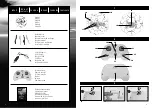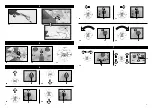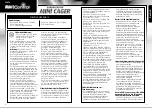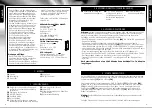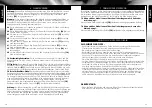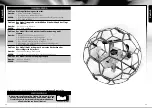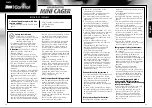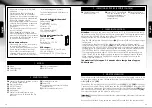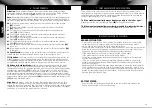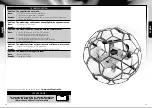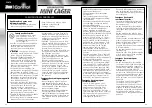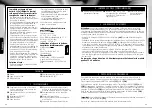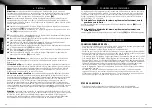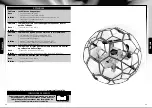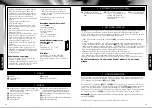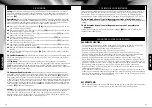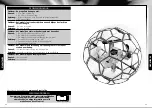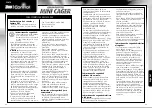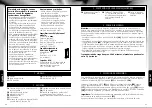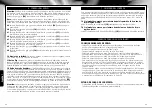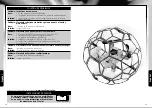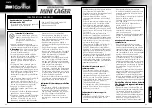
English
English
4 CHARGING THE MODEL
Attention:
The battery and motor must cool down for 15 to 30 minutes before charg-
ing and after every flight. Otherwise they can be damaged. The charging process must
be constantly monitored. Always ensure that the charging process takes place on a
fireproof surface in a fire-resistant environment.
• Plug the USB charger into an open USB port
(4A)
. The status LED on the charger begins
to illuminate.
• Carefully insert the other end of the charger into the model‘s charging socket,
checking that polarity (+/-) is correct
(4B)
. The charger should plug into the charging
socket easily – DO NOT USE FORCE. If the charger unit is not properly plugged into the
charging socket, this may damage the battery and could even present a risk to the user.
• The red LED on the USB charger goes out when the charging process starts.
• The charging process lasts approx. 40-60 minutes and must be continuously moni-
tored. The red LED on the charger lights up as soon as the charging process is finished.
• When charging is complete, unplug the model from the charger and unplug the
charger from the USB port.
The model can fly for approx. 5-6 minutes after a charge time of approx.
40-60 minutes.
3 INSERTING BATTERIES (REMOTE CONTROL)
3B
Insert 2 x 1.5 V AA batteries
and pay attention to the
polarity specifications, as
indicated in the battery
compartment.
3A
Carefully unscrew and
remove the cover.
3C
Close the battery
compartment cover.
• Never use a charger for NiCd/NiMH
batteries!
• Always ensure that the charging
process takes place on a fireproof
surface in a fire-resistant environment.
• Do not leave the battery unsupervised
during the charging process.
• Never disassemble or alter the battery
contacts. Do not damage or puncture
the battery cells. There is a risk of
explosion!
• The LiPo battery must be kept out of
reach of children.
• When disposing of batteries, they
must be discharged or their capacity
must be fully depleted. Cover exposed
terminals with adhesive tape in order
to prevent short-circuiting!
Maintenance and care:
• Please only use a clean, damp cloth
to wipe off the model.
• Protect the model and batteries from
direct sunlight and/or direct heat.
• Never allow the transmitter and
charging unit to come into contact
with water, because the electronics
will be damaged as a result.
Technical changes and differences in
color reserved!
Required batteries for the model:
Power supply:
Rated output:
1 x DC 3,7 V / 0,93 Wh
Batteries: 3,7 V
rechargeable
LiPo battery (included)
Capacity: 250 mAh
Battery requirement for the
remote control:
Power supply:
DC 3 V
Batteries: 2 x 1.5 V “AA”
(not included)
USB charger:
Power supply: DC 5V via USB port,
500 mA or higher
Rated output: 4,2 V / 500 mAh max.
2 REMOTE CONTROL
2A
Control for thrust and rotation, press in
to activate speed levels
2B
Trim for banking
2C
ON/OFF switch
2D
Headless mode
2E
No function
2F
Control for forward/reverse and
banking, press in to activate the flip
function
2G
Forward/reverse trim
2H
Power LED
2I
Locking screw and lever for battery
compartment
2J
Battery compartment cover
1 MODEL
1A
Rotors
1B
Protective cage
1C
Front LEDs
1D
Battery compartment
1E
ON/OFF switch
5 START PREPARATION
The model must be switched on first in order to connect it to the remote control. To do
so, place the model on an even, flat and solid surface. Then set the ON/OFF switch on the
model
(1E)
to „ON“
(5A)
.
To switch on the remote control, set the ON/OFF switch
(2C)
to „ON“
(5B)
. Wait about
5 seconds: the model will beep loudly once and the front LEDs
(1C)
on the model will
light up and stay illuminated. Now move the control for thrust and rotation
(2B)
all the
way up and then all the way down to unlock the remote control. The power LED
(2H)
now stays illuminated and the model is ready to use.
Important:
The model must be horizontal in the protective cage, otherwise it will not start
properly
(5C)
.
Once you have finished flying, switch the model off first and then the remote control.
A A
A A
16
17


